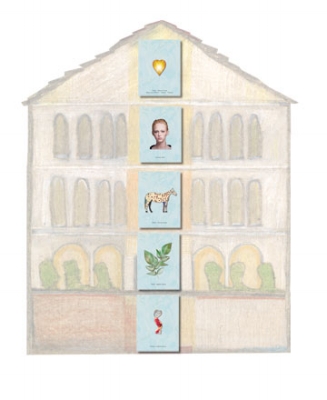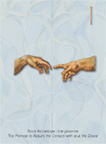Allergy: The ontology of an itch
Allergies are a godsend, for they take us back to the root of things–that which is deep and perpetual within us all. It takes us back further than Leah or Jacob. It takes us to a primary itch within: who am I? Where do I come from? What is my purpose?
>
“When I was 38 I noticed a strange scaly patch about the size of a silver dollar on the skin covering my right flank (quadratus lumborum), just below the last rib. I also began to see that certain shampoos would inflame a thin line of skin along my hairline, and when brushing my hair would note the snow shower of dried skin that would gently float down onto my shirt. This appalled me, for my mother had had a similar complaint when at 38 she developed a scaly and dried patches on her palm and sole of foot, on her right side. When I talked to her she recalled that one of her uncles had a severe case of psoriasis that had developed around (she couldn’t be specific) thirty-eight. This revelation of inheritance impassioned me to look more deeply into my complaint. As an osteopath and acupuncturist in the UK, I had attempted to help those with skin problems and allergies and often found that my limited understanding could not help those who appeared more at distress than my relatively innocuous and hidden complaint.”
Ontology
During this time I had been developing an ontological system using kinesiology and mudras or hand modes–a (sign) language that allows people to give us feedback, a narrative, about the root of their problems so that we can more efficiently know the causative reasons for their state. I used this system also and narrowed into my own problems: to understand the itch and the psora within me.
Homeopathy – miasma and psora
Samuel Hahnemann, the German physician who put homeopathy on the medical map at the beginning of the eighteen hundreds, talked of inherited patterns or miasma (Greek for stain, and fog) that we all inherit genetically. These were predispositions to certain types of human diseases that could result in structural unease, states of pathophysiology, pathological disease, and mental disorders. These patterns instructed us to play out genetic patterns of dysfunction.
Tsoret – psora – psoriasis – eczema – allergies
Hahnemann initially considered three primary miasmas: 1] psora, 2] syphilis, and 3] sycosis (gonorrhoea) and then added a fourth 4] tubercular. He thought the root miasm was psora. This word comes from the Hebrew “Tsoret” which infers the anguish and pain Leah felt, consequent to Rachel being taken as a second wife. Leah, the older and less beautiful (was said to be sloe-eyed) daughter, through a trick by Laban, their father, was secreted into the marriage bed instead of Rachel. Leah was married then, via consummation, to Jacob. Jacob of course, discovered the ruse and asked Laban for Rachel’s hand. With Laban’s consent, and for a further 7 years of tenured service, Jacob married Rachel a week later. However, this marriage deeply hurt Leah, who did indeed love Jacob. She always felt unloved even though she bore six children to Jacob. She named her first three children; Reuben (affliction), Simeon (unloved), and Levi (unattached) in reference to her anguish and pain towards her husband. Tsoret–psora–carries the taste of separation, outcast, unclean, barren, dirty, and rebellious. We see that this stigma is carried through our inherited ‘lot’ and manifests primarily as skin problems (the visual representation of unclean or untouchable)–hence psoriasis and eczemas but also other hidden ‘itches’–as in all allergies.
Separation
This conceptual model can be used to uncover what our particular itch is. What we are separate from. Human beings undergo rites of passage, forgotten in our secular times–as we move through into differing parts of our journey or lives. We become, in effect, further away and more separate (unconscious) from the Source. We are birthed–thus are separated from the ‘heaven’ of the womb, weaned and separated from the primal maternal nourishment (hence often milk and dairy allergies), separated from the innocence and freedom of childhood as we go through puberty, separated from being carefree and unencumbered as youth, as we enter into the responsibility of marriage or partnership. As we work through adult life we are often separated from life as work and survival become intertwined, and it makes it difficult for a larger perspective or nous to arise within us, as we retire, we again separate in our gradual preparation for death and all its uncertainty. In this life of ours, we are then separated from truth, from the source, from real nourishment. We need a signal to help us come back on track.
Signals – the ‘itch’
The human body signals us when we are separated from something that we need to understand. To do so, it makes us react and itch to what we call an allergen–an irritant. In previous articles, I have alluded to the human structure as if it were a house. That is; we consist of floors or areas of function within our body that mirror the functional aspects of a multi-storied house, containing a basement (material nature), living rooms (vegetal nature), areas of privacy and territory (animal nature), and places where we manage the house and its function (human nature). Our real house may also mirror our sense of identity (Self); our colonial nature, American, Slav, Pole, Hispanic, and African, through its design, décor, and furnishings just as our body displays physiognomy, racial characteristics, colour, and other nuances.
Our body is a house, containing levels of consciousness and being
Material itch
Allergens act as irritants to each aspect of the house (body). Minute microscopic, barely animate objects–dust, fungus, mites, mould–‘stuff’ that we might find in the damp, dark, and crowded basement will herald a primary inherited itch. Some small ‘seed’ left dormant setting off an ‘itch’ to signal its presence. It infers that we have some inherited itch that we need to resolve or conversely, some element that needs to come alive but is yet undifferentiated.
Vegetative itch
Food primarily comes from the vegetal and animal realms, and it may invade the blood as long-chain proteins (which are viewed as foreign) through a poorly differentiated and vulnerable digestive system (e.g. leaky gut) making us reactive albeit in a delayed manner. We then turn to absence and denial pushing aside the foods that would nourish our corporeal body–mirroring perhaps the lack of true nourishment in our inner or outer lives. The clues often, are illustrated by the food that we are irritated by. The root vegetable (grows hidden, deep in our soil), the seeds that irritate imitating a dormant seed within us, fruit (of a feeling or emotion), grain (staff of life) or dairy (primary maternal nourishment) that does not animate or bring us into life–all contain a clue about what is our archetypal models of nourishment; and of course what we are separate from. Hence the living room of our house is affected. We have difficulty fully living as we are not truly nourished.
Instinctual itch
Similarly, those who get rhinitis, conjunctivitis or dermatitis, and eczemas illustrate that the instinctual part of the self–the parts of the house that represent our territory or personal space–is absent in some way; we are not at home, not present but absent from our self or family. The first line of defence is then absent too–and thus the mucous membranes and skin lack their normal vigour–and do not do their job. Conversely, we may be irritated with some part of our ambition, sexuality, drive, motivation, or gender so we become irritated with animal by-products–dander and hair, the skin of certain animals (probably their dander) to illustrate our own intolerance with this part of the self. Infertility is also a rather disregarded aspect of this, as women or men may house a hidden antagonism towards the ‘other’ triggered by a myriad of reasons, none obvious. However, the consequence appears that the inviting eggs do not accept the sperm, or the sperm reacts to the eggs. The process may well then recapitulate in embryogenesis when in the process of differentiation within the blastocyst or minute embryo a ‘me and the ‘other’’ scenario gets played out at a cellular level.
(Both human [man-made] and identity [autoimmune] states are beyond the scope of this short article). Nevertheless, human irritants are in the realm of beliefs, thought forms, and archetypal patterns that sit on or in us. Noble patterns of allergy constitute irritability towards God, Higher ideas, etc., as in lofty thoughts, spiritual or religious notions, and manifest as auto-immune incompetence (against self).
Allergies – the itch in our being
Allergies are merely the seed ‘nudge’ that highlights that which is hidden from us. Initially, dust and mould, fungi, and mites are of negligible or minor importance, so we don’t really ’see’ them as irritants. The being, inherent within us, amps up the force of the initial irritant and makes us then become irritable with how we are nourished or jacks up the power so much that we become absent or distracted so that our animal protective nature does not defend us from environmental pollutants, pollens and the like. The wisdom within us is extraordinary. Our being wants us to sit up and take notice. Unfortunately, as our medicine is often based on pharmaceutical intervention we use either conventional means that mask the symptoms or ‘alternatives’ that fortify our systems but actually do a similar job. Alternative medicine is often a soft medicine, as it tries to alter the environment of the person–our physiology–to mitigate the effects of an irritant or calm down the hypersensitivity. It doesn’t always get at the root; albeit homoeopathy certainly tries to do so. Our modern approach is to talk about mind body and spirit, play lip service to the mind, and notice the body but often do not really understand that it is the Spirit that provides the gift by giving us the itch. Our essence cries to us about our Original Promise–what we came into this life to change, alter, transform, grow through.
An ontological approach
The Promise to return
There are simple procedures that help to ease and remove the allergy. This is by looking at the root cause within you, and noting the area that is affected which serves as the clue. For example, the basement serves us to point and look at inherited patterns that lie dormant yet present within us. Perhaps there are things ‘dead’ within us so that fungus gets a hold on the decaying part of us. Perhaps there is a dead or dormant feeling running through us, so our digestive tract fills with candida albicans as the mycelia entangle our genitals and innards with their tentacles. This makes us feel unclean and perhaps inhibits intimacy, as the feeling (vegetal self) within, that entangles, us may simply be one that pushes us away from our sexuality (animal self). Simple processes help to break the incessant noise in the system to break the facilitated mechanism that constantly trips us into the allergic response. You almost never have to take people off foods, rotate diets, give shots or mask the symptoms–there is no need to. Once listened to, the being stabilizes its housing and the functional parts of us go back to their normal and usually silent job.

